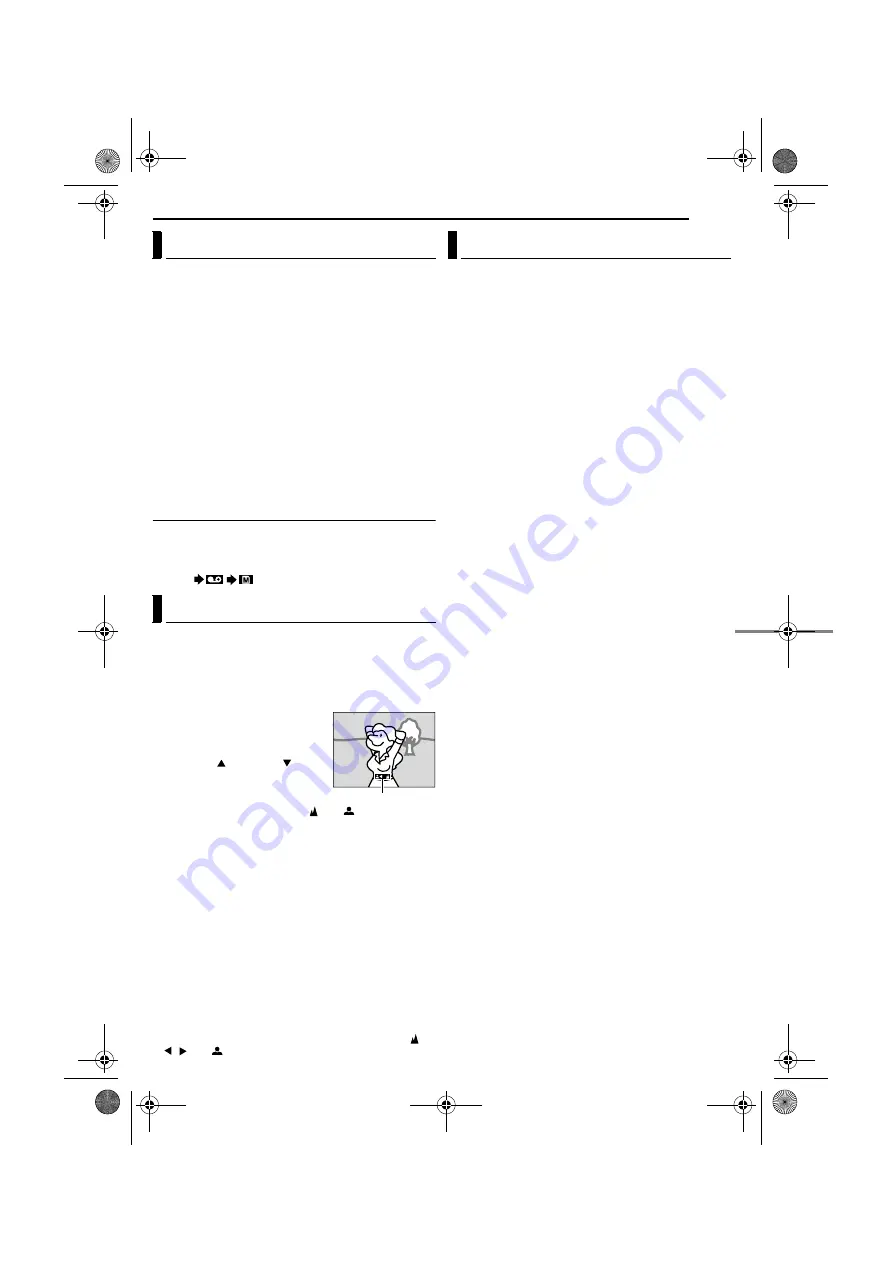
FEATURES FOR RECORDING
EN
35
MasterPage: Advan_Right
This feature lets you record still images that look like
photographs onto a tape.
1
Set the
VIDEO/MEMORY
Switch to “VIDEO”.
2
Set the Power Switch to “
M
”.
3
Set “SNAP MODE” to the desired mode.
4
Press
SNAPSHOT
.
●
There is the sound effect of a shutter closing.
●
The “
O
” indication appears and a still image will be
recorded for approx. 6 seconds, then the camcorder re-
enters the Record-Standby mode.
●
You can perform Snapshot also during recording. A still
image will be recorded for approx. 6 seconds, then the
normal recording resumes.
●
Regardless of the Power Switch position (“
A
” or “
M
”),
Snapshot recording takes place using the selected
Snapshot mode.
●
Flash will not work in “VIDEO” mode.
Motor Drive Mode
Keeping
SNAPSHOT
provides an
effect similar to serial photography. (Interval between still
images: approx. 1 second)
●
The Motor Drive mode is disabled when “REC SELECT” is
set to “
/
”. (
The camcorder’s Full Range AF system offers
continuous shooting ability from close-up (as close as
approx. 5 cm (2") to the subject) to infinity.
However, correct focus may not be obtained depending
on the shooting condition. In this case, use the manual
focus mode.
1
Set the Power Switch to “
M
”.
2
Press the
FOCUS
lever. The
manual focus indicator appears.
3
Slide up (
) or down (
)
the
FOCUS
lever to focus on a
subject.
●
When the focus level cannot be
adjusted any further or closer, “
” or “
” will blink.
4
Press
SET
. Focus adjustment is complete.
To reset to Auto Focus
Press
FOCUS
once.
Manual focus is recommended in situations listed
below.
●
When two subjects overlap in the same scene.
●
When illumination is low.*
●
When the subject has no contrast (difference in brightness
and darkness), such as a flat, one-color wall, or a clear,
blue sky.*
●
When a dark object is barely visible in the LCD monitor or
the viewfinder.*
●
When the scene contains minute patterns or identical
patterns that are regularly repeated.
●
When the scene is affected by sunbeams or light reflecting
off the surface of a body of water.
●
When shooting a scene with a high-contrast background.
* The following low-contrast warnings appear blinking:
,
,
and .
Manual exposure control is recommended in the
following situations:
●
When shooting using reverse lighting or when the
background is too bright.
●
When shooting on a reflective natural background such as
at the beach or when skiing.
●
When the background is overly dark or the subject is bright.
1
Set the Power Switch to “
M
”.
2
Press
EXPOSURE
.
●
The exposure control indicator appears.
3
To brighten the image, press
e
. To darken the image,
press
w
. (maximum ±6)
●
+3 exposure has the same effect as the backlight
compensation. (
●
–3 exposure has the same effect as when “
r
” is set to
“SPOTLIGHT”. (
4
Press
SET
. Exposure adjustment is complete.
To return to automatic exposure control
Press
EXPOSURE
twice. Or, set the Power Switch to
“
A
”.
NOTES:
●
You cannot use the manual exposure control at the same
time when “
r
” is set to “SPOTLIGHT” or “SNOW”
pg. 38), or with the backlight compensation.
●
If the adjustment does not cause any visible change in
brightness, set “GAIN UP” to “AUTO”. (
Snapshot (For Video Recording)
Manual Focus
Manual focus indicator
Exposure Control
GR-DZ9_DZ7US_07Advanced.fm Page 35 Wednesday, June 2, 2004 7:11 PM






























